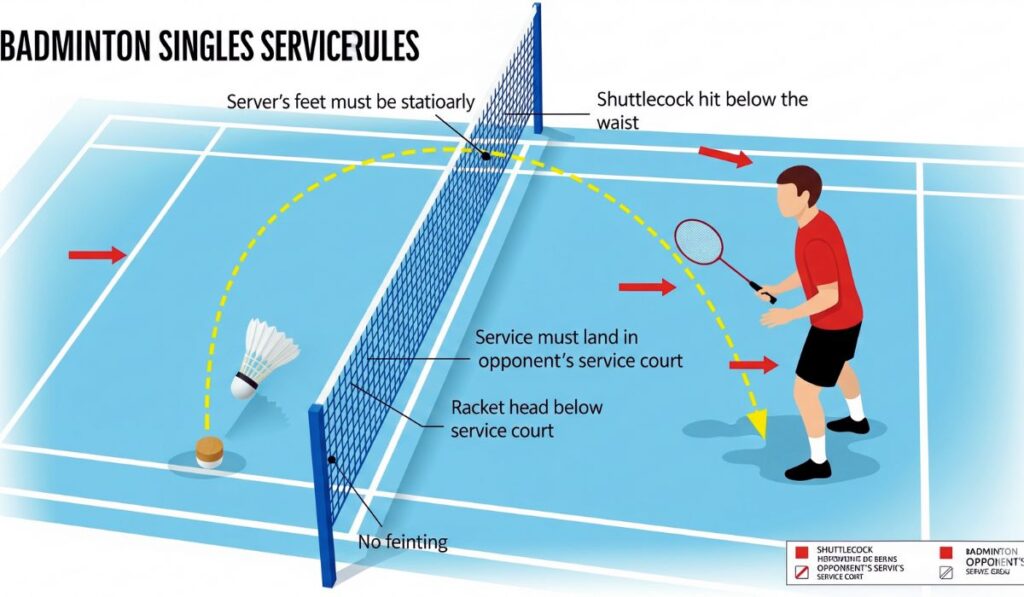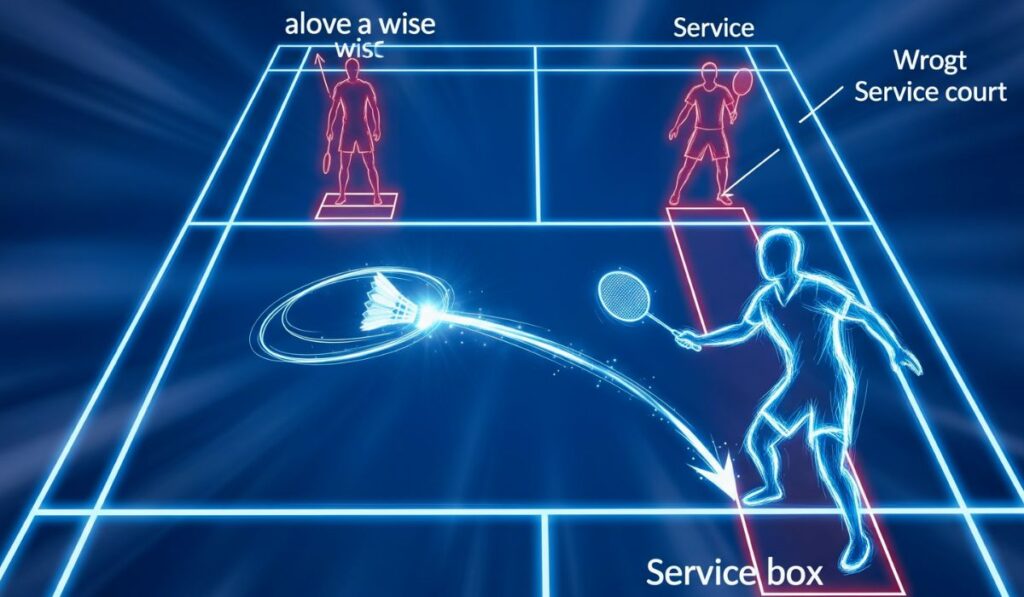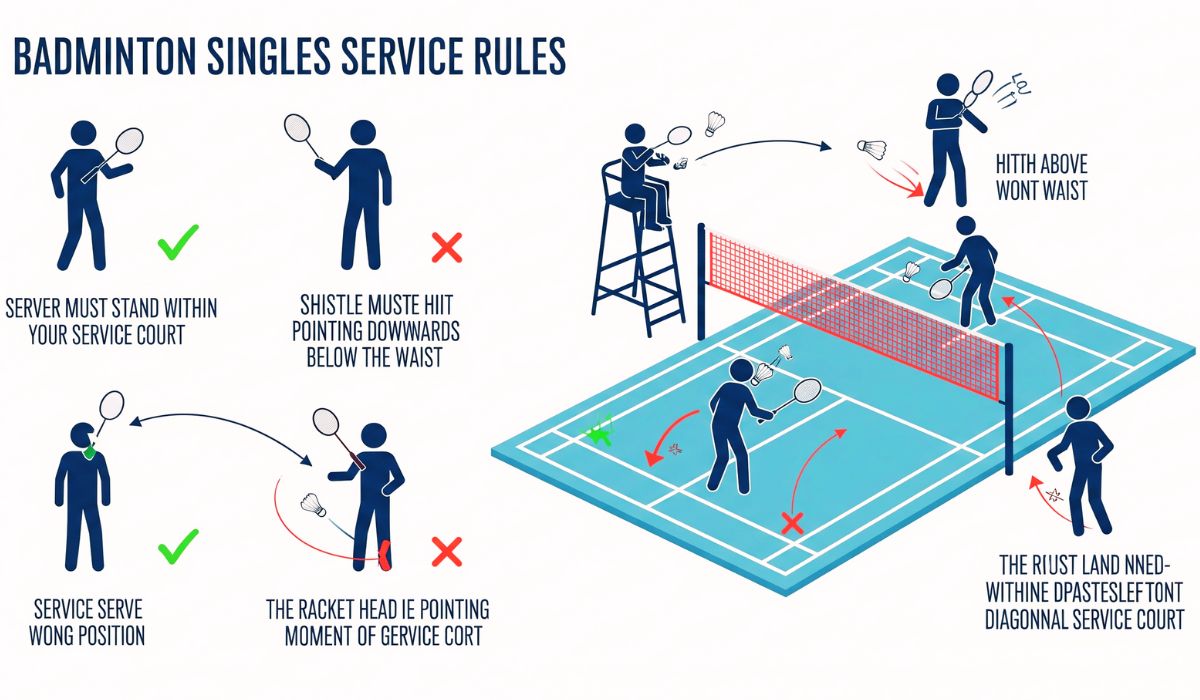Avoid These Common Mistakes: Serve Rules That Most Players Misunderstand
Understanding the badminton singles service rules is essential for anyone serious about the sport—or simply wanting to avoid embarrassing faults. These rules may seem rigid or even unfair at first, but they are carefully designed to create fairness, rhythm, and strategy in matches. Learning them thoroughly helps you serve with confidence, react calmly to calls, and maintain composure under pressure.
The Court Setup and Serving Position
In Badminton Singles Service play, the court width is narrowed (5.18 m), and players serve into diagonally opposite service boxes. According to the official laws, when your score is even, you serve from the right box; when it’s odd, from the left. This rule keeps Badminton Singles Service rotations predictable, reduces confusion, and creates subtle tactical depth—knowing your serve position guides how you prepare for the return.
Feet Placement: Keep Them Solid and Line-Free
For a valid serve, both of your feet must stay in contact with the ground, and none can touch any court line during. It’s surprisingly easy to feel confident about a serve—you lift a heel just slightly and suddenly you’ve made a fault. Keeping your stance firm and lines untouched builds discipline and reduces those frustrating footslash penalties.
Hitting Below the Waist: Why It Still Matters
Though earlier versions allowed Badminton Singles Service below the rib cage, modern laws require the shuttle’s entire base (cork) to be struck below 1.15 m from the court during official. While many local clubs still default to the “waist rule,” elite play now enforces service height strictly. Serving too high not only risks a fault—it shifts play tempo and credibility.
Forward Movement: No Stalling Allowed
After your backswing begins, the racket must move continuously forwards until contact is made. Stopping mid-motion or faking a serve is considered a fault. BWF clarified this in 2024 to prevent players from using trick serves to buy time or unsettle opponents. Good servers understand that clean intention, not subtle delay, creates reliability.

Shuttle Contact: Cork First, No Feather Spins
The racket must strike the shuttle at the cork base—not a feather—for a legal serve. Recently, BWF extended a ban on “spin serves” (intentionally spinning the shuttle via feather contact) until January 2025 as part of fair-play enforcement. Mastering clean, cork-first serves improves consistency—and avoids bizarre illegal spin delays.
Avoiding Undue Delay: Play with Flow
Umpires now enforce a clause that prohibits unnecessary delay once both players are “ready.” Standing idle with racket poised or delaying serve is restricted. It’s an effort to keep matches moving and reduce gamesmanship. A swift, focused serve not only prevents penalties but also keeps you mentally sharp.
Court Lines Don’t Leave You Alone
If your foot touches any boundary line during Badminton Singles Service—sideline, centre line, or short service line—it’s an immediate fault. Reflexively, players need to step away from lines as they swing. That one misstep—even when faint—can cost a point. Solid pre-serve routine helps eliminate these errors.
Understanding Service Rotation in Singles
When the server wins a rally, they earn a point and serve again—but from the alternate service court . If the receiver wins, the serve passes to them, and they serve from their correct court (based on odd/even score). This rotation system introduces rhythm into rallies and Badminton Singles Service behavior—each serve has meaning, each movement counted.
Serving Therefore Scored: Rally-Point System
Since 2006, Badminton Singles Service matches use rally scoring—every rally yields a point, regardless of who served. This change shifted serve dynamics drastically: instead of safe serves to retain serve, you must now serve to win points. That simple shift affects aggression, placement tactics, and mental approach.
Edge Cases: Let Returns and Service Errors
If a serve nets or fails to cross but meets other conditions, it may be replayed as “let,” depending on circumstances. Badminton Singles Service court errors—like serving from the wrong box or out-of-turn—sometimes lead to a “let” or corrected serve if spotted quickly. These fine distinctions make varying decisions across leagues. Awareness keeps you from being caught out.
Why Bewildering Rules Build Better Players
While the badminton singles service rules can feel overzealous—especially around foot placement or service height—they force players to refine technique. You become aware of balance, intention, and racket control. That surgical precision raises your overall game—serving becomes not just about winning points, but creating confidence and rhythm in your tennis-like share of the court.
Tackling Common Faults: Practical Examples
Most players commit serve faults in these common ways:
- Lifting a foot ever so slightly during motion
- Hitting the shuttle above waist or at the feathers
- Serving from wrong box after a point transition
- Pausing too long after motion begins
- Touching the lines under pressure
Training deliberately under weak light or after games helps build consistent technique, avoiding these physical pitfalls.
Emotional Stakes of a Faulty Serve
Nothing disheartens like a faulty serve at 20–20. Momentum shifts instantly. That’s why mental toughness matters. Use your serve routine to reset emotionally: deep breath, foot alignment check, visualizing an ideal serve. This shift builds a gap between physical action and emotional reaction, reinforcing strategy over panic.
Practicing Like a Pro
Top coaches train players with Badminton Singles Service drills focusing on:
- Serving within strict height and motion limits
- Matching odd-even score serve transitions
- Drills for returning unpredictable serves
- Mimicking delayed umpire whistles (practicing stillness after motion begins)
This dedication turns rules into muscle memory—not obstacles.
How Rule Changes Impact Coaching
Recent changes—like banning spin serve and enforcing no delay—mean coaches must update training plans. Players used to spin-based grace serves or subtle pauses now must adapt to clearer motion and cleaner execution. Trainers incorporate video review and rule-based drill analysis so players self-correct before mistakes cost matches.
Gender, Age, and Rule Enforcement Variations
In junior levels or local clubs, umpires may give more leniency on minor infringement—especially regarding delay or height inaccuracies. But in adult tournaments, these elements are strictly enforced. Younger players benefit from early exposure to correct technique; older players trained on outdated customs may need to retrain habits to comply with official standards.
Equipment and Measurement Tools Matter
In international matches, Badminton Singles Service height is measured using a device to ensure the shuttle is below 1.15 m at hit time. Local clubs may still use the traditional waist-based guideline, but that is rapidly becoming obsolete. Knowing which system applies helps you adjust your serve accordingly—no surprises during tournaments.
Serving Strategy: How Rules Define Tactics
The serve can be a weapon—not just a formality. Legal underarm flicks, tight short serves, or deep baseline drives become strategic tools. With the odd-even court rule, your serve position hints at handedness, tactical intention, and even psychological pressure points. Mixing placements while staying legal sharpens both opponents’ expectations—and your own edge.
Why Singles Serve Rules Raise the Skill Bar
The precision demanded by badminton singles service rules elevates elite play. Clean serve mechanics reduce errors, timing mismatches, and rally unpredictability. Players who internalize these rules develop a sharp eye for detail—foot alignment, wrist angle, shuttle timing. Over months, those micro-adjustments compound into stronger serves, sharper returns, and smarter gameplay.
Understanding the Foundation of Singles Service Rules
Badminton Service service rules are crucial to fair play and flow. Unlike doubles, the singles format has stricter court boundaries and a more straightforward service structure. Each rally begins with a serve, and knowing the precise placement and movement can define the game. The serve must be hit diagonally across the court from the right service box if the server’s score is even and from the left if odd. Understanding this foundational rule gives players clarity and helps avoid Badminton Singles Service faults that can cost crucial points.
Importance of Correct Service Positioning
Positioning while serving in Badminton Singles Service is non-negotiable. Both feet must remain in contact with the floor inside the service box without touching any boundary lines. Many beginners make the mistake of stepping on or over the line, resulting in a fault. Correct posture ensures better balance and accurate delivery. It also aligns your body for a smoother transition into rally mode. Ignoring this detail, even slightly, could lead to an immediate loss of Badminton Singles Service.
Racket and Shuttle Placement Rules
According to official rules, the shuttle must be hit below the waistline when serving. More specifically, the racket’s head should be pointing downwards, and the shuttle must be struck below the rib cage. This ensures fairness and avoids aggressive serves that can be difficult to counter. These rules maintain the essence of sportsmanship and fair play. Ignoring them can lead to frequent service faults and unnecessary penalties.
Faults That Haunt Players in Singles Matches
Badminton Service service rules list several faults that can ruin a serve. If the shuttle is struck above the waist, if it lands outside the correct Badminton Singles Service box, or if the server fakes a movement, it’s counted as a fault. Double hits, racket clashes, or shuttle misplacement also constitute faults. These errors often arise due to nervousness or lack of practice. Awareness and constant refinement of technique can reduce these faults.
Role of the Umpire in Enforcing Service Rules
In professional play, umpires monitor every serve closely. Their job includes ensuring that each serve complies with all Badminton Singles Service rules, especially racket height and shuttle trajectory. Even minor violations are penalized. Players must respect the umpire’s judgment, as arguing can lead to disciplinary action. For recreational players, a neutral observer can serve as an umpire to ensure the game runs smoothly.
The Consequence of Repeated Faults
Repeated Badminton Singles Service faults can lead to point loss and momentum shifts. In tightly contested matches, this can be mentally damaging. The emotional pressure of knowing that every serve counts can impact concentration. Practicing consistent serves and mentally rehearsing before the match can reduce the risk of repeated infractions. Players often use visual cues and breathing techniques to stay grounded.
How Singles Service Differs from Doubles
The main distinction lies in the boundaries. In Badminton Singles Service, only the inner side and back boundary lines are in play, unlike doubles, where the outer sidelines matter during the serve. This creates a narrower court to target and calls for more precision. Additionally, doubles service techniques like flicks or drives are rare in singles, where the focus is on depth and control. Knowing this distinction helps players avoid confusion and strategy mismatches.
The Psychological Edge of a Perfect Serve
Executing a flawless serve boosts confidence. It immediately puts pressure on the opponent and sets the pace. A well-placed high serve in Badminton Singles Service pushes the opponent to the backcourt, giving the server time to settle. Psychological preparation is as important as physical training. Visualizing a successful serve before stepping onto the court sharpens mental focus and reduces errors.
Ideal Techniques for Mastering the Singles Serve
A simple, effective serve in Badminton Singles Service involves a clean lift with moderate power. Players must avoid trying to overpower the shuttle, as that can lead to faults. Precision is key. Practicing corner-to-corner diagonal serves with a focus on consistency helps sharpen accuracy. Use video feedback to analyze body posture, shuttle contact point, and swing fluidity.
The Controversy Around ‘Waist Height’ Rule
One of the most debated rules is the definition of ‘waist height.’ Different players have different interpretations, especially those with varying body heights. The BWF has tried to address this by defining waist level as a specific height above the court. Despite this, controversies remain, especially in high-stakes games. Clearer guidelines or wearable tech may become future solutions.
How Service Rules Influence Strategy in Singles
Badminton Singles Service service rules are more than just formalities—they shape tactics. Players often use a high serve to force the opponent to the backcourt, opening up the mid-court and front for net play. Others use deceptive low serves to catch aggressive returners off-guard. Understanding the rules allows players to use legal but cunning variations that add unpredictability.
Training Drills to Improve Your Singles Serve
Badminton Singles Service drills are essential. One effective drill is marking target zones in the opponent’s service box and practicing 20–30 consecutive serves. Alternating between high and low serves improves adaptability. Mirror practice also helps players fix their foot posture and swing motion. Partner drills where a coach or peer shouts ‘left’ or ‘right’ randomly just before the serve enhance on-the-spot decision-making.
The Role of Grip in Executing a Legal Serve
The grip used during a serve has a major impact on legality and effectiveness. Most players use a forehand grip for Badminton Singles Service high serves. However, an incorrect grip can cause wrist stiffness or upward shuttle contact. Practicing grip switching and relaxing the wrist can enhance accuracy and reduce strain. A wrong grip, though subtle, is a silent service killer.

Game-Changing Errors to Avoid When Serving
Many players, especially under pressure, rush their serves. Haste often leads to faults, from foot placement violations to poor shuttle contact. Another common error is overcomplicating the serve with unnecessary wrist flicks. Simplicity wins. Focus on the fundamentals—stance, contact point, and follow-through. Avoiding these errors can greatly increase point conversion.
Legal Deceptions: What the Rules Allow in Singles Serves
While faking a serve is illegal, subtle deception like varying the speed or slightly altering the angle is allowed. These tricks can disrupt an opponent’s rhythm. Practicing such legal deceptions under a coach’s supervision ensures fairness and creativity. Mastering this grey zone within the rulebook is an art that often gives experienced players an edge.
Impact of Environmental Conditions on Serve Legality
Factors like wind in outdoor settings or uneven flooring can affect serve accuracy. In such scenarios, players must adjust their stance and shuttle angle. Shoes with proper grip and regular practice under various conditions help prepare for such challenges. Players ignoring these details often blame their performance on bad luck instead of planning better.
Misconceptions That Hurt Your Singles Serve
One common myth is that power is the key to a successful serve. In reality, control and placement matter more. Another misconception is that a good serve guarantees the point. While it sets the tone, the follow-up play is equally vital. Understanding what really matters in Badminton Singles Service service is the first step toward improvement.
Insights from Pro Players on Mastering the Serve
Professional players emphasize rhythm and calmness while Badminton Singles Service. They often take a few seconds to breathe deeply before delivering the serve. Their post-serve body positioning is strategic—they prepare for any possible return direction. Watching pro matches with attention to serves can be both inspiring and educational for any level of player.
How to Recover After a Faulty Serve
Every player makes mistakes, but what defines a winner is how they recover. After a faulty serve, take a moment to refocus. Avoid negative self-talk. Visualize the next serve and trust your training. Positive reinforcement, even in the face of errors, keeps the momentum from slipping away.
Future of Badminton Singles Service Rules
With advancing technology, we may soon see service monitoring or standardized height sensors. These tools could eliminate controversy and improve fairness. While purists may resist these changes, modern players need to adapt. Staying informed about potential updates ensures that players are not caught off guard.
Final Thoughts: Serving With Skill and Understanding
At first, mastering the singles service rules—feet flat, shuttle low, motion fluid—can feel rigid, even daunting. But from discipline comes freedom. Understanding these rules gives you consistency, strategy, and mental composure. Whether you’re new or returning to badminton, committing to these laws means serving with confidence, avoiding embarrassments, and playing smarter. These rules don’t just shape your serve—they shape your game.


1 thought on “Why Badminton Singles Service Rules Can Be Confusing Yet Empowering (Here’s What Matters)”